
BioMed Central
Page 1 of 9
(page number not for citation purposes)
Cough
Open Access
Research
Short reflex expirations (expiration reflexes) induced by
mechanical stimulation of the trachea in anesthetized cats
Ivan Poliacek*1,2, Melanie J Rose1, Lu Wen-Chi Corrie1, Cheng Wang1,
Jan Jakus2, Helena Barani2, Albert Stransky2, Hubert Polacek3,
Erika Halasova4 and Donald C Bolser1
Address: 1Department of Physiological Sciences, College of Veterinary Medicine, University of Florida, PO box 100144, 1600 SW Archer Road,
Gainesville, Florida, 32610-0144, USA, 2Department of Medical Biophysics, Jessenius Faculty of Medicine, Comenius University, Mala Hora 4,
037 54, Martin, Slovakia, 3Clinic of Radiodiagnostics, Jessenius Faculty of Medicine, Comenius University, Martin, Slovakia and 4Department of
Medical Biology, Jessenius Faculty of Medicine, Comenius University, Martin, Slovakia
Email: Ivan Poliacek* - poliacek@jfmed.uniba.sk; Melanie J Rose - rosem@mail.vetmed.ufl.edu; Lu Wen-Chi Corrie - venkaiwc@gmail.com;
Cheng Wang - wangc@mail.vetmed.ufl.edu; Jan Jakus - jakus@jfmed.uniba.sk; Helena Barani - barani@jfmed.uniba.sk;
Albert Stransky - stransky@jfmed.uniba.sk; Hubert Polacek - polacek@jfmed.uniba.sk; Erika Halasova - halasova@jfmed.uniba.sk;
Donald C Bolser - bolserd@mail.vetmed.ufl.edu
* Corresponding author
Abstract
Fifty spontaneously breathing pentobarbital-anesthetized cats were used to determine the
incidence rate and parameters of short reflex expirations induced by mechanical stimulation of the
tracheal mucosa (ERt). The mechanical stimuli evoked coughs; in addition, 67.6% of the stimulation
trials began with ERt. The expiration reflex mechanically induced from the glottis (ERg) was also
analyzed (99.5% incidence, p < 0.001 compared to the incidence of ERt). We found that the
amplitudes of abdominal, laryngeal abductor posterior cricoarytenoid, and laryngeal adductor
thyroarytenoid electromyograms (EMG) were significantly enhanced in ERg relative to ERt. Peak
intrathoracic pressure (esophageal or intra-pleural pressure) was higher during ERg than ERt. The
interval between the peak in EMG activity of the posterior cricoarytenoid muscle and that of the
EMG of abdominal muscles was lower in ERt compared to ERg. The duration of thyroarytenoid
EMG activity associated with ERt was shorter than that in ERg. All other temporal features of the
pattern of abdominal, posterior cricoarytenoid, and thyroarytenoid muscles EMGs were equivalent
in ERt and ERg.
In an additional 8 cats, the effect of codeine administered via the vertebral artery was tested.
Codeine, in a dose (0.03 mg/kg) that markedly suppressed cough did not significantly alter either
the incidence rate or magnitudes of ERt.
In the anesthetized cat the ERt induced by mechanical stimulation of the trachea was similar to the
ERg from the glottis. These two reflex responses differ substantially only in the frequency of
occurrence in response to mechanical stimulus and in the intensity of motor output.
Published: 28 April 2008
Cough 2008, 4:1 doi:10.1186/1745-9974-4-1
Received: 14 December 2007
Accepted: 28 April 2008
This article is available from: http://www.coughjournal.com/content/4/1/1
© 2008 Poliacek et al; licensee BioMed Central Ltd.
This is an Open Access article distributed under the terms of the Creative Commons Attribution License (http://creativecommons.org/licenses/by/2.0),
which permits unrestricted use, distribution, and reproduction in any medium, provided the original work is properly cited.

Cough 2008, 4:1 http://www.coughjournal.com/content/4/1/1
Page 2 of 9
(page number not for citation purposes)
Background
Forceful expirations are substantial part of airway defense.
They arise particularly during tracheal and laryngeal
coughs, sneeze, and the expiration reflex. Basic character-
istics of these behaviors are known (see e.g. [1,2]) includ-
ing the complex movement of the larynx [3-5].
The expiration reflex (ER) is characterized by a single and
short expulsion without a preceding inspiration. ER is reg-
ularly induced from the glottis (ERg) by mechanical stim-
ulation. Its function is to expel foreign particles from the
upper airways by fast expiratory airflows [1,6]. The reflex
represents a fundamental aspiration prevention mecha-
nism [7] and is significant particularly in gastro-esopha-
geal reflux [8], in laryngopharyngeal reflux [9,10], and
under other conditions when a risk of the aspiration is
markedly increased.
Several authors have observed short reflex expirations that
were not preceded by an inspiration during stimulation in
the trachea (ERt) of cats [11,12], dogs [13], and humans
[14]. Others reported that from 1/3 [15] up to 60% ([16],
also personal communication) of repetitive cough epi-
sodes induced in lower airways of anesthetized cats began
with expulsion. The presence of an ER in response to
mechanical stimulation of the trachea represents an
important component of airway defense related to aspira-
tion prevention. This behavior presumably is a "backup"
to ER from the larynx and serves to eject foreign material
from the trachea when the laryngeal ER (ERg) has failed to
prevent aspiration. The extent to which these tracheal
expirations (ERt) represent unique behaviors induced
from stimulation of the lower airways is unknown. Some
authors concluded that the ERt and ERg are the same
behavior and they used the term "expiration reflex" for
both of them [7,15]. However, this conclusion is based
only on qualitative inspection of the motor patterns.
Additional evidence is required to support the conclusion
that ERt and ERg are identical reflexes.
The purpose of this study was to quantitatively examine
multiple ERt induced by mechanical stimulation of the
tracheobronchial airways in cats, to determine their inci-
dence rate, and to compare their mechanical and electro-
physiological characteristics with ERg. We hypothesized
that ERt and ERg may represent essentially the same reflex
behavior elicited from two different regions of the air-
ways.
Methods
All procedures were performed in accordance with the
NIH Guide for the Care and Use of Laboratory Animals,
the Animal Welfare Guidelines of the University of Flor-
ida, the ethical rules, and the legislation of USA and Slo-
vakia. The protocols were approved by Ethics committee
of Jessenius Faculty of Medicine Commenius University
and the State veterinary administration of Slovakia (N°
5492/1999-500 and 6708/03-220) or by the University of
Florida Institutional Animal Care and Use Committee
(N° 8663-2004).
Experiments were performed on 58 spontaneously
breathing adult cats. Fifty cats (3.44 ± 0.11 kg), 42 of them
females, were used to determine an incidence rate and
behavioral characteristics of the ERt. Eight cats were tested
for the effect of intravertebral administration of codeine
on ERt. The animals were anesthetized with sodium
pentobarbital (35–40 mg/kg i.p. or i.v.). Supplementary
doses were administered (1–3 mg/kg, i.v.) as needed.
Atropine (0.1 – 0.2 mg/kg, i.v.) was given at the beginning
of the experiment to reduce secretions. Seventeen out of
50 animals were also used in brainstem recording proto-
cols and received hydrocortisone (9 mg/kg) to prevent
brain edema. The trachea, femoral artery and vein were
cannulated. An esophageal balloon was used for measur-
ing intrathoracic pressure alterations in 33 cats and a pleu-
ral cannula was placed in 17 animals. Arterial blood
pressure, end-tidal CO2, and body temperature were con-
tinuously monitored. Body temperature was maintained
at 37.5 ± 0.5°C by a heating lamp and a pad. Arterial
blood samples were periodically removed for blood gas
analysis. The animals breathed air mixtures that were
enriched by oxygen (25 – 60%) as required to maintain
arterial pO2 values above 13 kPa (100 mm Hg).
In 8 cats a cannula was introduced into the left brachial
artery and the tip was positioned near the origin of the
vertebral artery. All other branches of the subclavian artery
in the region were clamped so the codeine (a single dose
of 0.03 mg/kg) was delivered directly to the brainstem cir-
culation.
Electromyograms (EMG) of respiratory muscles were
recorded with bipolar insulated fine wire electrodes. We
recorded EMGs from the expiratory abdominal muscles
(ABD) transversus abdominis, rectus abdominis or exter-
nal oblique, from the inspiratory parasternal muscles
(PS), in 17 animals and in an additional 8 "codeine" cats
alternatively from the diaphragm (DIA), in 42 animals
from the inspiratory laryngeal posterior cricoarytoneid
muscle (PCA), and in 39 cats from the expiratory laryn-
geal thyroarytenoid muscle (ThAr). The PS electrodes were
placed at T3 proximal to the sternum. The DIA electrodes
were introduced into the crural diaphragm. Transversus
abdominis and rectus abdominis (or external oblique)
electrodes were placed 3–4, respectively 1 cm lateral to the
linea alba. The PCA electrodes were inserted along the
dorsal surface of the arytenoid cartilage using its dorsal
edge as a visual cue after gently elevating the larynx. The
ThAr electrodes were inserted directly through the crico-

Cough 2008, 4:1 http://www.coughjournal.com/content/4/1/1
Page 3 of 9
(page number not for citation purposes)
thyroid membrane. Proper placement of each set of elec-
trodes was confirmed by the appropriate inspiratory or
expiratory phased activity during breathing and other res-
piratory events as well as by visual inspection.
Animals (except the 8 codeine cats) were placed prone in
a stereotaxic frame and the dorsal surface of medulla was
exposed by an occipital craniotomy for later interventions
in the brainstem under another protocol. The medullary
surface was covered by warm paraffin oil.
Mechanical stimulation of the intrathoracic trachea
(between the edge of tracheal cannula and the carina) was
performed with a thin polyethylene catheter (diameter 0.5
– 1.0 mm) or nylon fiber (diameter 0.2 – 0.5 mm) for the
period of 5–20 s. Six to 18 stimulation trials (11.2 trials in
an average) were conducted without any additional inter-
vention (the time interval between stimulation trials was
approximately 1 minute). The stimulations elicited ERt
and single or repetitive coughs (Fig. 1). We used a
mechanical stimulus on the glottis with the thin nylon
fiber (diameter 0.2 mm) in order to induce ERg. In an
additional 8 codeine cats, 20 – 30 mechanical stimulation
trials were conducted to establish a stable cough baseline.
Then 5 control pre-codeine stimulus trials were applied
during the period of 5 min, followed by 5 stimulus trials
after the intra-vertebral administration of the codeine
(0.03 mg/kg).
The ERt from the trachea (Fig. 1, 2 and 3) and ERg from
the glottis were both defined as a brief short burst of ABD
electrical activity with positive swing of esophageal or
pleural pressure without a preceding inspiration. The
response induced in the inspiratory phase of breathing
regularly and immediately terminated inspiration. No
coactivation of inspiratory (PS or DIA) and expiratory
activity (ABD) was observed either in ERt (Fig. 2) or in ERg
[4,5]. Cough was defined as a coordinated inspiratory-
expiratory sequence manifest as a large burst of inspira-
tory EMG activity immediately followed by a burst of
expiratory ABD activity with an inspiratory-expiratory
waveform of intrathoracic pressure (Fig. 1). These criteria
The reflex responses to the mechanical stimulation (stim) in the tracheaFigure 1
The reflex responses to the mechanical stimulation (stim) in the trachea. Two quiet breaths (slight inspiratory
increase in the records of laryngeal abductor posterior cricoarytenoid – PCA and parasternal muscles – PS EMG moving aver-
ages with a depression in esophageal pressure – EP) followed by a short reflex expiration (ERt) at the beginning of stimulation
(steep elevations in EMG moving averages of laryngeal adductor thyroarytenoid muscle – ThAr, PCA, and abdominal muscles –
ABD, as well as in EP). The ERt was then followed by 3 coughs in which the expulsions caused slight elevations of blood pres-
sure (BP). Moderate post-inspiratory activity was present at the inspiratory-expiratory transition of quiet breathing in ThAr.
The ERt was markedly shorter compared to the cough expulsions (see ABD and EP) leading to the lower amplitude of EP com-
pared to that in coughs, although the amplitudes of ABD EMG moving averages remained comparable.

Cough 2008, 4:1 http://www.coughjournal.com/content/4/1/1
Page 4 of 9
(page number not for citation purposes)
separated ERt or ERg from cough and also from other air-
way defensive behaviors such as augmented breath and
aspiration reflex.
All EMGs were amplified, filtered (300 – 5000 Hz), recti-
fied, and integrated (time constant 50 ms). We analyzed
for both the ERt and ERg: (1) the number and the inci-
dence rate, (2) the amplitudes of ABD, PCA and ThAr
EMG moving averages, (3) the peak of esophageal or pleu-
ral pressure, (4) the duration and time correlations of
PCA, ThAr, and ABD activities. Magnitudes of the ABD,
PCA, and ThAr moving averages were normalized to the
strongest tracheal cough reflex. The characteristics of ERt
and ERg in cats treated with hydrocortisone and chest wall
surgery (in order to insert pleural cannula, 17 cats) were
similar to those measurements taken from animals with-
out such interventions (33 cats). Thus, the final analysis
was performed on all these 50 cats.
Results are expressed as a mean values ± SEM. Incidence
rate of ERt and ERg, their occurrence in trials that began
during inspiration and expiration, the number of cats
selected for analysis of ERt/ERg parameters (ERt or ERg ≥
0.2 kPa (> 1.5 mm Hg)), and the number of animals with
analyzed laryngeal muscles EMGs were processed with the
Fisher's exact test. The parameters of ERt and ERg were
compared using unpaired t-test, Welch corrected unpaired
t-test, and Mann-Whitney test (Table 1). The paired t-test
was used to compare ERt ABD EMG amplitudes in
codeine-treated cats. The differences of variables were
considered significant at p < 0.05.
Results
We conducted 562 tracheal stimulation trials in 50 ani-
mals, 326 of them began in the expiratory period of
breathing (58%), 236 in inspiration (42%). The stimula-
tion induced cough (Fig. 1) and during 380 stimulation
trials also ERt (67.6%, Fig. 1, 2 and 3). ERt typically
appeared at the beginning or very early stage of the tra-
cheal stimulation (Fig. 1, 2 and 3). For 380 stimulation
trials with ERt, 263 trials began in expiration (69.2%),
117 in inspiration (30.8%). No ERt were detected in 182
trials (32.4%); 117 of these non-responding stimulations
began during inspiration (64.3%,), 65 trials in expiration
(35.7%). ERt was significantly more elicitable in expira-
tion (p < 0.001, Fisher's test).
We selected 28 animals with multiple ERt in which the
magnitude of the expulsion reached at least 0.2 kPa (120
ERt, 99 of them induced in expiration, 21 in inspiration)
for further analysis. The ABD EMG of 34 out of 120 ERt
consisted of two bursts in close succession; another 26
Mechanical stimulation of the trachea (stim) with short reflex expiration (ERt) during the inspiratory period of breathingFigure 2
Mechanical stimulation of the trachea (stim) with short reflex expiration (ERt) during the inspiratory period of
breathing. The stimulation immediately terminated an inspiration (rapid suppression of PCA and PS) and induced the ERt
(abrupt activation of ThAr, PCA and ABD). Two much weaker ERt were detectable in the record of ABD, before the initial
cough inspiration began (activation of PCA at the end of the record). See Fig. 1 for abbreviations.

Cough 2008, 4:1 http://www.coughjournal.com/content/4/1/1
Page 5 of 9
(page number not for citation purposes)
were multiple burst complexes. Only the largest compo-
nent of these multi-burst responses was measured. The
characteristics of the PCA EMG were examined during 96
ERt in 23 cats and that of ThAr during 86 ERt in 20 cats
(Table 1). The PCA EMG responded with a short burst of
activity that slightly preceded the ABD activity. The ThAr
was activated even earlier than the PCA and then sup-
pressed while ABD EMG activity reached its peak (Fig. 3).
However, a prolongation of ThAr activity during ERt was
recorded in 62 out of 86 ERt; a second prolonged activity
of ThAr appeared after the ABD burst (Table 1, Fig. 1, 2
and 3).
Glottal stimuli applied in 31 animals produced ERg
99.5% of the time (426 out of 428 stimulations, 279 dur-
ing expiration and 149 during inspiration). The animals
with multiple ERg, pressure amplitudes of which reached
at least 0.2 kPa, were included in further analysis (211 ERg
in 27 cats, 150 of them in expiration and 61 in inspira-
tion; Table 1). The features of laryngeal muscle activities
were measured on 176 ERg in 22 cats (Table 1).
No significant differences between the characteristics of
ERt or ERg that were induced in expiration vs. inspiration
were found.
The intra-vertebral administration of codeine (0.03 mg/
kg) did not affect the incidence rate of ERt (23/40 vs. 21/
40 in control, p > 0.81, Fisher's test) and their ABD EMG
amplitudes (5 ± 1% vs. 10 ± 4% in control, p > 0.32,
paired t-test) compared to the ERt in pre-codeine control.
This intervention reduced the number of tracheal coughs
by 73% (p < 0.01, paired t-test) and cough ABD EMG
amplitudes from 46 ± 8% to 9 ± 4% (p < 0.01, paired t-
test).
Discussion
The major finding of this study was that quantitative anal-
ysis of mechanically induced ERt and ERg revealed a high
degree of similarity between these two behaviors.
The patterns of ABD, PCA, and ThAr were similar during
both ERt and ERg. Laryngeal adductor ThAr was activated
first, then PCA and ABD followed. During the maximum
ABD bursting suppression of ThAr was detected that was
frequently followed by another prolonged burst of ThAr
activity. We propose that such patterns in activation of
ThAr, PCA, and ABD may represent 3 phases of laryngeal
movement during ERt, which are the compressive, expulsive,
and subsequent constriction phase analogously to those
found in ERg [4,5,17].
Motor pattern of short reflex expiration (ERt) induced by mechanical stimulation of the trachea (stim)Figure 3
Motor pattern of short reflex expiration (ERt) induced by mechanical stimulation of the trachea (stim). See Fig.
1 for abbreviations.


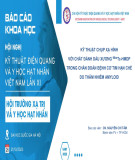
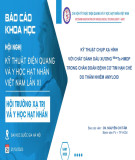
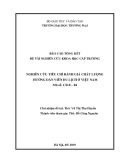
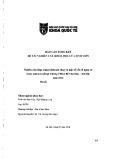
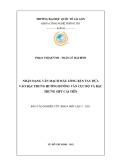
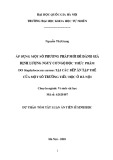
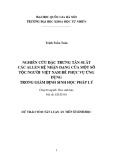
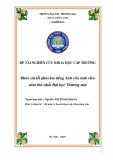
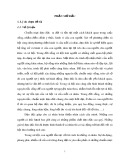





![Báo cáo seminar chuyên ngành Công nghệ hóa học và thực phẩm [Mới nhất]](https://cdn.tailieu.vn/images/document/thumbnail/2025/20250711/hienkelvinzoi@gmail.com/135x160/47051752458701.jpg)









